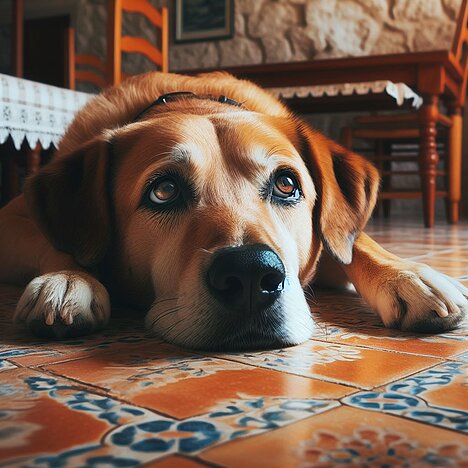Dorsal laminectomy

You may have heard of a dorsal laminectomy, an operation performed on dogs with spinal cord injuries or herniated discs. But what exactly is a dorsal laminectomy and how does it work? In this blog post, you'll find out everything you need to know about this treatment method.
What is a dorsal laminectomy?
A dorsal laminectomy is a surgical procedure in which part of the vertebral arch is removed to relieve pressure on the spinal cord. The vertebral arch is the bony part of the vertebra that surrounds the spinal cord. If the vertebral arch is damaged or deformed, it can compress the spinal cord and lead to pain, paralysis or other neurological problems.
A dorsal laminectomy is most commonly used in dogs with herniated discs that do not respond to conservative therapies such as pain medication, anti-inflammatories or physiotherapy. A herniated disc is a condition in which the intervertebral disc, which acts as a buffer between the vertebrae, slips out of position and presses on the spinal cord. This can be caused by trauma, ageing or genetic factors.
How does a dorsal laminectomy work?
A dorsal laminectomy is a complex and invasive procedure that should only be performed by an experienced veterinarian. The dog must be thoroughly examined before the operation to determine the exact location and extent of the herniated disc. This may include X-rays, computer tomography (CT) or magnetic resonance imaging (MRI).
The operation itself is performed under general anesthesia and takes between one and three hours, depending on the number of vertebrae affected. The vet makes an incision along the spine and exposes the spinal cord. He then carefully removes the affected part of the vertebral arch using a special saw or drill. This relieves the pressure on the spinal cord and the disc can be removed or repositioned.
After the operation, the dog is closed with stitches or staples and has to stay in hospital for a few days. He will be given painkillers, antibiotics and other medication to promote healing and prevent infection. He will also need to wear a collar to prevent him from licking or scratching at the wound.
What are the risks and complications of a dorsal laminectomy?
As with any surgery, there are some risks and possible complications associated with a dorsal laminectomy. These include:
- Bleeding
- infections
- Nerve damage
- Recurrence of the herniated disc
- Loss of bladder or bowel emptying
- Loss of pain sensation
- Stiffening or curvature of the spine
Most of these complications are rare or can be treated with medication or further surgery. The success rate of a dorsal laminectomy is around 80 to 90 percent, which means that most dogs show an improvement in their symptoms after surgery. However, the outcome depends greatly on the severity and duration of the herniated disc as well as the age and health of the dog.
What is the aftercare of a dorsal laminectomy?
The aftercare of a dorsal laminectomy requires a lot of patience and commitment from you as the dog owner. You need to help your dog recover from the surgery and restore their mobility and quality of life. This includes:
- Checking the wound regularly and removing the stitches or staples after about 10 to 14 days
- Administering painkillers, antibiotics and other medications as directed by the vet
- Restricting the dog's activity and exercise for at least six weeks to aid healing. This means keeping your dog on a lead, avoiding climbing stairs and not letting him jump or play.
- Undertaking physiotherapy or hydrotherapy to strengthen the muscles, lubricate the joints and promote circulation. This can include massages, stretching, passive movements or swimming.
- Adjusting the dog's diet and weight to maintain a healthy spine. This means giving your dog a balanced and nutritious diet and avoiding obesity.
A dorsal laminectomy is a serious surgery that should only be considered as a last resort for your dog. However, it can be an effective treatment for dogs with severe spinal cord injuries or herniated discs that do not respond to other therapies. If you decide to have a dorsal laminectomy, be prepared to provide your dog with intensive follow-up care to speed his recovery and improve his quality of life.
The authors assume that a veterinarian should be consulted if an animal is ill and that medication should only be taken after consultation with a doctor or pharmacist. Only an individual examination can lead to a diagnosis and treatment decision.
We help you find the nearest vet → This way